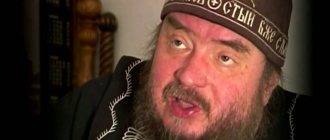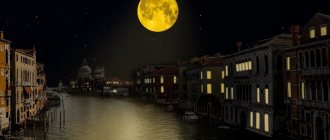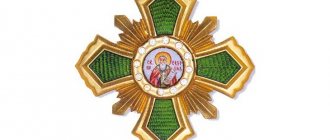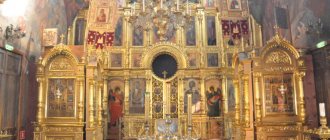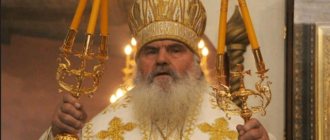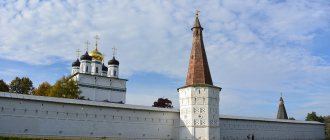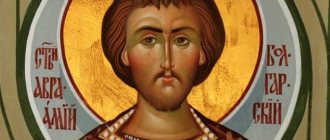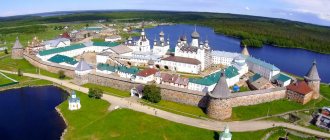Ambiguous information is published about the Bishop of the Russian Orthodox Church Zosima (Ostapenko).
On the official website of the Moscow Patriarchate he is listed as a worthy hierarch with titles and awards.
And the news publication “Caucasian Knot” talks about some excesses and abuses of power.
We will talk about Archbishop Zosima (Ostapenko), now the administrator of the Solikamsk diocese.
Archbishop Zosima Ostapenko, Administrator of the Solikamsk Diocese
Archbishop Zosima Ostapenko was left an orphan at the age of 14 and after the army he studied at a theological seminary
The future hierarch, Vladimir Mikhailovich Ostapenko, was born in Kazakhstan, Tselinograd region, p. Novocherkassk, in a family of employees. Left orphaned at the age of 14, he graduated from boarding school, after which he served 2 years of military service in the Armed Forces of the Soviet Army.
After the army he entered the Moscow Theological Seminary. During his studies, he performed obedience in a church in the Moscow region, Odintsovo district, village. Dmitrovskoe.
After graduating from the seminary, in Makhachkala he served as a psalm-reader in the Church of the Dormition of the Mother of God.
Seven years later, he was ordained a deacon by Archbishop Anthony, and a month later - a priest.
Appointed to serve as a full-time priest at the Church of the Archangel Michael in Grozny.
Three years later he was transferred to the Holy Cross Church, which was the only one in Kalmykia at that time, in the village. Sheltered. A year later he was transferred to Elista and appointed rector of the Holy Cross Church. He was tonsured a monk with the name Zosima, in honor of the Venerable Zosima of Solovetsky
After two years, with the blessing of Archbishop Anthony of Stavropol and Baku, he was tonsured with the name Zosima, elevated to the rank of abbot and appointed dean of all Kalmyk parishes.
As a dean, he opened the first Sunday school in the diocese, built the Kazan Cathedral in Elista, and laid the foundations for the construction of two churches in the diocese. He was elected as a deputy of the Supreme Council of Kalmykia.
Eight years later he was elected to the position of Bishop of Elista and Kalmykia. Patriarch Alexy II of Moscow elevated him to the rank of archimandrite, then to bishop. After eleven years - to the rank of archbishop.
1995
this year Zosima Ostapenko was elevated to the rank of bishop
Five years later, by the decision of the Holy Synod, Vladyka Zosima becomes the manager of the Vladikavkaz and Makhachkala departments. In the same year, Archbishop Zosima of Vladikavkaz was appointed to the position of rector of the Alan Dormition Monastery (village Khidikus, Republic of North Ossetia-Alania).
A year later, Archbishop Zosima was given the title “Vladikavkaz and Alan”, in connection with the newly formed Makhachkala diocese.
Four years later, due to health reasons, he was dismissed and moved to Moscow. Five months later, he was appointed Archbishop of Solikamsk and Chusovsky.
Dates of the life path of Vladika Zosima
| date | Event |
| July 12, 1950 | Birthday |
| 1968 | Finished school |
| 1968-1970 | Military service |
| 1970-1974 | Studying at the Moscow DS |
| December 13, 1981 | Ordained deacon |
| December 27, 1981 | Ordained priest, Grozny |
| 1984 | Appointed to parish in Kalmykia |
| 1985 | Appointed rector of the Holy Cross Church, Elista |
| August 21, 1987 | Took monastic vows |
| October 7, 1995 | Elevated to the rank of archimandrite |
| December 24, 1995 | Consecrated Bishop |
| October 6, 1995 | Appointed bishop of the Elista and Kalmyk diocese |
| February 24, 206 | Elevated to the rank of archbishop |
| March 22, 2011 | Appointed Bishop of Vladikavkaz and Makhachkala |
| June 3, 2016 | Sent to rest |
| October 21, 2016 | Appointed bishop by the Solikamsk diocese |
Archbishop Zosima has medals and orders, and not only church ones
| Father Zosima's Award | Name |
| Order of Friendship of Peoples, Russia | |
| Medal "For the Glory of Ossetia" of the Republic of North Ossetia | |
| Order of the Holy Blessed Prince Daniel of Moscow, II degree, Russian Orthodox Church | |
| Order of St. Sergius of Radonezh, II degree, Russian Orthodox Church | |
| Order of St. Seraphim of Sarov II degree, Russian Orthodox Church | |
| Order of St. Innocent of Moscow II degree, Russian Orthodox Church | |
| Medal "For Merit", Federal Migration Service, Russian Federation |
Memory of Zosima Sokur
Having passed away, the great Donetsk elder still spiritually nourishes Orthodox Christians thanks to numerous video, audio, and printed materials.
Movies
In 2012, the 10th Pokrov Film Festival took place in Kyiv. It presented the film “Father Zosima”, directed by Olga Mironchuk. The film tells about the life and spiritual path of the famous Donetsk elder; it became an unforgettable event in the lives of many people not only from Ukraine, but also from Russia and other countries.
In the film you can see people who knew Fr. Zosima, listen to their memories. Thanks to them, the truthful and majestic appearance of the Donetsk elder emerges, who treats all people with great love. At the end of the film, the text of the priest’s spiritual testament is presented - the only truthful version remaining today.
About Fr. Zosima has also shot many other videos, for example, in 2003 - “Funeral Prayer”, “The Road of Life”. All of them introduce us more closely to the elder, his teachings, and prophecies.
Books
Books with the biography and instructions of Fr. Zosima. They reveal the appearance and essence of the great elder’s life feat.
Here are some of them:
- A Word about Holy Rus' (ed. Sretensky Monastery);
- What the soul grieves about (similarly);
- Love is above all (ed. “Orthodox Evangelist”).
Posthumous veneration of the priest is only increasing in Russian Orthodoxy. New books are being published, videos appear with memories of the deceased elder. More and more Christians are turning to his teachings, seeking spiritual help and advice in them.
Interview with Bishop Zosima and his sermons
- Interview of Archbishop Zosima of Vladikavkaz and Makhachkala to the Interfax-Religion portal
- Archbishop of Vladikavkaz and Alan Zosima: Orthodoxy in Ossetia has the deepest roots
- Bishop of Elista and Kalmyk ZOSIMA (Ostapenko) (ROC MP): “It is impossible to allow such an active promotion of Catholicism in Russia, which was the case under Pope John Paul II”
- Archbishop of Vladikavkaz and Alan Zosima: Just as the Caucasus cannot exist without Russia, so Russia without the Caucasus is incomplete
- Word from Archbishop Zosima on the desecration of the Buddha statue in Elista
- Sermon by Bishop Zosima on the occasion of the Epiphany
Archbishop Zosima Ostapenko had a conflict with his flock in North Ossetia
After his appointment to the Vladikavkaz and Makhachkala Sees, Archbishop Zosima, as the ruling bishop, pursues his own personnel policy. The actions of the ruler, an uncompromising person and categorical in his statements, led to an open conflict.
The reason for the confrontation was the appointment of the abbot of the Alan Holy Dormition Monastery, Archimandrite Anthony (Danilov), to Dagestan.
The believing parishioners fell in love with Father Anthony and did not want to part with him.
Despite the requests of the people, the archbishop remained adamant. He motivated that Father Anthony’s extensive missionary experience would bring more benefits in the new place, and in the future the archimandrite would be elevated to the rank of bishop.
The mass indignation of believers, fueled by the hot Caucasian temperament, turned into a conflict between the diocese and the government of the republic. The government took the side of the people.
A group of believers who disagreed with the bishop put their dissatisfaction on paper, collected signatures, and sent them to Moscow. The conflict had to be resolved by the Patriarch. As a result, Vladyka Zosima withdrew the order to appoint Archimandrite Anthony.
By leaving a comment, you accept the user agreement
Personality of Metropolitan Zosima
In the second half of the 15th century, events took place in Rus' that for a long time predetermined the paths of its socio-political development. It was during that period of Russian history that the spiritual and political foundations of the statehood of Moscow Rus' were laid. Therefore, that time was marked by very intense polemics on many religious and political issues.
The emergence and spread of the Moscow-Novgorod heresy of the “Jewish wise men” also dates back to this time. The essence of this heretical movement, the political and religious views of the heretics are still largely unclear. It is impossible to name with complete confidence the true founders of false teaching, and it is impossible to determine the goals they pursue.
But still, despite the mysterious mystery surrounding the heretics, from among them, according to many researchers and scientists, several people can be identified who played a special role in the Judaizer movement. Their number includes the primate of the Russian Church from 1491 to 1494, Metropolitan Zosima Brodaty.
The question of the religious beliefs of Metropolitan Zosima is one of the most important. Many historians, including A.V. Kartashev, S.M. Soloviev, Metropolitan Macarius (Bulgakov) [1] and some others, classify him as a follower of the Judaizer heresy that was spreading in Moscow at that time. As the first, albeit indirect, evidence of this, the long delay in choosing a successor to the late Metropolitan Gerontius is cited. A.V. Kartashev, in particular, writes: “The assumption naturally arises that the court spheres, infected with the secret teachings of the Judaizers, were engaged in an intrigue to appoint a candidate favorable to them to the metropolitan table. The result of the intrigue justifies our hypothesis. Archimandrite Zosima of the Simonov Monastery was installed as metropolitan on September 26, 1490.”[2] And indeed, the efforts on intrigue were not in vain, since the “installation of the heretic Zosima as metropolitan” brought the secret society of Judaizers to a dominant position not only in the administrative-state sphere, but also in the field of church government.
In order to understand the true nature of Zosima’s religious views, one should first of all pay attention to the historical aspect and the main dogmatic provisions of the heresy, of which he is often considered one of the followers.
So, the heresy of the Judaizers dates back to 1471, when the “Jew Skhariya” was in the retinue of the Kiev-Lithuanian prince Mikhail Olelkovich, who was invited to Novgorod. Together with the warlock, sorcerer and astrologer Shariya, other Jews arrived in Novgorod. It was no coincidence that the Jews began to undermine Orthodoxy from Novgorod. This important trading center of Rus' was closest to the West; any freethinking quickly reached this city along trade routes along with imported goods.
And it was precisely during that period that there was fierce opposition to Moscow from the Lithuanian party. In the Battle of the Sheloni River on July 14, 1471, the Moscow army completely defeated the Novgorod militia. In August 1471, the defeated Novgorodians signed treaty documents with John III, according to which the Moscow sovereign still made all sorts of concessions to the Novgorod identity, but made the Novgorodians undertake to not go over to the side of Lithuania and to consecrate their bishop in Moscow.
In 1484, after a series of new unrest and unrest, Gennady, archimandrite of the Chudov Monastery, became archbishop in Novgorod. And all these years, starting from 1471, the heresy of the Jew Skhariya secretly spread throughout Novgorod. This Jew was not concerned with propaganda among the people. He was interested in the clergy and the top of society. First of all, Skhariya managed to seduce two priests - Dionysius and Alexy. Through them, false teaching penetrated into Moscow, when both secret heretics were invited to the capital by the Grand Duke. Continuing the 1000-year-old traditions of secret Jewish sects, the Judaizers opposed Christian teaching, denied the Holy Trinity, and blasphemed the Son of God and the Holy Spirit. They rejected the Divinity of the Savior and His incarnation, they denied the Second Coming of Christ and His Last Judgment. Heretics rejected the apostolic and patristic writings and all Christian dogmas, denied church institutions: sacraments, hierarchy, fasts, holidays, churches, veneration of icons. They especially hated monasticism. In the organization of the Judaizing sect, much was reminiscent of future Freemasonry: strict secrecy; penetration into the highest levels of government and clergy; a ritual that includes the “rite” of desecration of a shrine. Being irreconcilable enemies of Christianity, the Judaizers hid their hatred of it, secretly hoping to gradually destroy it from within. Seducing with astrology and witchcraft, Skaria and other Jews who arrived with him boasted of Kabbalah, ancient legends that allegedly came to them from Moses. Many even claimed that they had a book that Adam received from God, that they knew all the secrets of nature, that they could explain dreams, guess the future, and command spirits. In a word - sorcerers and sorcerers.
Thus, the Judaizers had at least a conditional doctrinal system, expressed, however, in all sorts of denials of Christian dogmas and postulates. Let us now turn to Metropolitan Zosima. His actual views and views are little known to us, since researchers talk about only one work by the metropolitan, known as “Notice about Paschal.” But N.I. Kostomarov claims that he was “prone to unbelief and materialism”[3]. Proof of which, for example, can be his disbelief in the afterlife, which is unusual for Judaizers. Joseph Volotsky attributes the following words to the Metropolitan: “What is the kingdom of heaven, what is the second coming, what is the resurrection of the dead? There is nothing of this: whoever died died, and that’s all; until then and was while he lived in the world.” It can be assumed that Zosima did not seek to burden himself with any religious framework and obligations, and was not, in fact, even a Judaizer. According to N.I. Kostomarov, “the denial of a future life was inconsistent with generally accepted Jewish beliefs, and it seems that Zosima did not belong to any heresy, but simply did not believe in anything, because he did not care about anything”[4].
That is probably why Zosima was put forward as a contender for the high priestly throne: it is easy to manage a person concerned only with sensual pleasures. This can be confirmed at least by the Council of 1491, which, at the insistence of Gennady of Novgorod, condemned some heretics. Instead of the death penalty, which the Novgorod Archbishop insisted on, the heretics were simply exiled to various monasteries, from where they continued to send out their destructive letters saturated with heresy. Such a punishment, due to the severity of the age and the importance of debauchery, was very philanthropic and could only be imposed with the intervention of the metropolitan, who, expelling those who disagreed with heresy and those who fought against it, said that the priest in the church should preach only universal peace.
As noted above, Metropolitan Zosima was subject to many serious vices, such as sodomy and even bestiality. His moral state, therefore, did not withstand any canonical criticism. Hieromonk Tarasius (Kurgan) writes about the customs accepted in the circles of Judaizers, to which Zosima was directly related, citing the words of the Rev. Joseph of Volotsky: “Sexual promiscuity, which constitutes the essence of their life and is only covered up by false biblical teaching, has reached the extreme limits of a pathological phenomenon. Not to mention unnatural mixtures, with some kind of pleasure incomprehensible to a healthy person, they desecrated the chaste in a very special way: “I bring harlots into my temples,” writes St. Joseph, “and I defile myself with them with fornication and wash with them in the tub and this foul water.” I take and pour this into wine and honey and send that wine and honey to the saints and priests, and to the bolyars and to the guests and to all Orthodox Christians.” The Monk Joseph is not exaggerating at all, claiming that “psychics don’t eat anything like that”.”[5]. In addition, and all historians agree on this, Zosima was very fond of various festivities and, as a result, was prone to the sin of drunkenness.
Ironically, it was Zosima, a man unworthy to occupy the metropolitan see, who, in the Paschal newly created at the end of the 15th century, voiced the vitally important position for Rus' at that time that Moscow, after the fall of Byzantium, became the city of the “new Constantine.” And the Grand Duke of centralized Rus' in the person of John III is transformed into the “new Constantine.” It can, however, be assumed that all the metropolitan’s exaltation of the Grand Duke boiled down, in fact, to only one thing - the opportunity to enlist reliable support for the ruler in the fight against the defenders of Orthodoxy, who openly opposed Zosima.
According to N.I. Kostomarov, “Zosima could not hide for long. The zealots of piety soon figured him out, were seduced by his behavior, his ambiguous antics, about which rumors spread among the people, and began to denounce him. The Metropolitan, who had previously preached mercy to everyone, now began to complain to the Grand Duke about his enemies, and the Grand Duke subjected some to imprisonment.”[6] But after the Monk Joseph of Volotsky turned to the episcopate with a bold call to expel the heretic from the throne of St. Peter and a ban on asking the Metropolitan for blessings (“teach all Orthodox Christianity so that they do not come to this nasty apostate for a blessing” [7]), she rose up against Zosima the whole Church. And as a result, by the decision of the Council of 1494, the former metropolitan was exiled first to Simonov, and then to the Trinity Monastery for correction. Even here, the sadness of the top of the Judaizers and the personal kind attitude of John III toward him, based purely on flattery, were evident: Zosima was deposed not for the heresy of which he was accused, but for drunkenness and negligence about the Church.
To summarize, we can safely say that Metropolitan Zosima is one of the worst high priests of the Russian Church in its entire centuries-old history. Perhaps not being a convinced follower of the heresy of the Judaizers, he still, due to his heavy adherence to all kinds of passions, was not, according to the canons, worthy not only of primacy, but even of the lower degrees of the priesthood. However, in opposition to Metropolitan Zosima and his like-minded people, the Russian Church acquired unique experience in the struggle for the purity of Orthodoxy, a struggle based on the conciliar church mind.
[1] See about this: Kartashev A.V.
Essays on the history of the Russian Church.
M.: Republic, 1994; Macarius (Bulgakov),
Metropolitan. History of the Russian Church. M.: Publishing house. Spaso-Preobrazhensky Valaam Monastery, 1994–1996.
[2] Kartashev A.V.
Decree. op. P. 237.
[3] Kostomarov N.I.
Russian history in the biographies of its main figures. M.: Olma Press, 2004. Book. 3. P. 22.
[4] Ibid.
[5] Tarasy (Kurgan)
, hieromonk. A turning point in ancient Russian theology. M.: Publishing House of the Krutitsky Compound, 2003. P. 44.
[6] Kostomarov N.I.
Decree.
op. P. 24 .
[7] Russia: past, present future: Materials of the All-Russian Scientific and Practical Conference. St. Petersburg, December 16–19, 1996 / Ed. M.S. Uvarov. St. Petersburg: Publishing house BSTU, 1996. P. 2.
